AmirEmad Ghassami
Causal Discovery in Linear Models with Unobserved Variables and Measurement Error
Jul 28, 2024Abstract:The presence of unobserved common causes and the presence of measurement error are two of the most limiting challenges in the task of causal structure learning. Ignoring either of the two challenges can lead to detecting spurious causal links among variables of interest. In this paper, we study the problem of causal discovery in systems where these two challenges can be present simultaneously. We consider linear models which include four types of variables: variables that are directly observed, variables that are not directly observed but are measured with error, the corresponding measurements, and variables that are neither observed nor measured. We characterize the extent of identifiability of such model under separability condition (i.e., the matrix indicating the independent exogenous noise terms pertaining to the observed variables is identifiable) together with two versions of faithfulness assumptions and propose a notion of observational equivalence. We provide graphical characterization of the models that are equivalent and present a recovery algorithm that could return models equivalent to the ground truth.
Two-Stage Nuisance Function Estimation for Causal Mediation Analysis
Mar 31, 2024
Abstract:When estimating the direct and indirect causal effects using the influence function-based estimator of the mediation functional, it is crucial to understand what aspects of the treatment, the mediator, and the outcome mean mechanisms should be focused on. Specifically, considering them as nuisance functions and attempting to fit these nuisance functions as accurate as possible is not necessarily the best approach to take. In this work, we propose a two-stage estimation strategy for the nuisance functions that estimates the nuisance functions based on the role they play in the structure of the bias of the influence function-based estimator of the mediation functional. We provide robustness analysis of the proposed method, as well as sufficient conditions for consistency and asymptotic normality of the estimator of the parameter of interest.
Identification and Estimation for Nonignorable Missing Data: A Data Fusion Approach
Nov 15, 2023



Abstract:We consider the task of identifying and estimating a parameter of interest in settings where data is missing not at random (MNAR). In general, such parameters are not identified without strong assumptions on the missing data model. In this paper, we take an alternative approach and introduce a method inspired by data fusion, where information in an MNAR dataset is augmented by information in an auxiliary dataset subject to missingness at random (MAR). We show that even if the parameter of interest cannot be identified given either dataset alone, it can be identified given pooled data, under two complementary sets of assumptions. We derive an inverse probability weighted (IPW) estimator for identified parameters, and evaluate the performance of our estimation strategies via simulation studies.
Partial Identification of Causal Effects Using Proxy Variables
Apr 23, 2023



Abstract:Proximal causal inference is a recently proposed framework for evaluating the causal effect of a treatment on an outcome variable in the presence of unmeasured confounding (Miao et al., 2018; Tchetgen Tchetgen et al., 2020). For nonparametric point identification of causal effects, the framework leverages a pair of so-called treatment and outcome confounding proxy variables, in order to identify a bridge function that matches the dependence of potential outcomes or treatment variables on the hidden factors to corresponding functions of observed proxies. Unique identification of a causal effect via a bridge function crucially requires that proxies are sufficiently relevant for hidden factors, a requirement that has previously been formalized as a completeness condition. However, completeness is well-known not to be empirically testable, and although a bridge function may be well-defined in a given setting, lack of completeness, sometimes manifested by availability of a single type of proxy, may severely limit prospects for identification of a bridge function and thus a causal effect; therefore, potentially restricting the application of the proximal causal framework. In this paper, we propose partial identification methods that do not require completeness and obviate the need for identification of a bridge function. That is, we establish that proxies of unobserved confounders can be leveraged to obtain bounds on the causal effect of the treatment on the outcome even if available information does not suffice to identify either a bridge function or a corresponding causal effect of interest. We further establish analogous partial identification results in related settings where identification hinges upon hidden mediators for which proxies are available, however such proxies are not sufficiently rich for point identification of a bridge function or a corresponding causal effect of interest.
Causal Discovery in Linear Latent Variable Models Subject to Measurement Error
Nov 08, 2022Abstract:We focus on causal discovery in the presence of measurement error in linear systems where the mixing matrix, i.e., the matrix indicating the independent exogenous noise terms pertaining to the observed variables, is identified up to permutation and scaling of the columns. We demonstrate a somewhat surprising connection between this problem and causal discovery in the presence of unobserved parentless causes, in the sense that there is a mapping, given by the mixing matrix, between the underlying models to be inferred in these problems. Consequently, any identifiability result based on the mixing matrix for one model translates to an identifiability result for the other model. We characterize to what extent the causal models can be identified under a two-part faithfulness assumption. Under only the first part of the assumption (corresponding to the conventional definition of faithfulness), the structure can be learned up to the causal ordering among an ordered grouping of the variables but not all the edges across the groups can be identified. We further show that if both parts of the faithfulness assumption are imposed, the structure can be learned up to a more refined ordered grouping. As a result of this refinement, for the latent variable model with unobserved parentless causes, the structure can be identified. Based on our theoretical results, we propose causal structure learning methods for both models, and evaluate their performance on synthetic data.
A Unified Experiment Design Approach for Cyclic and Acyclic Causal Models
May 20, 2022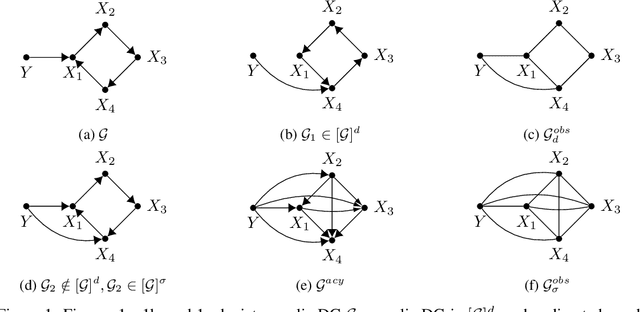

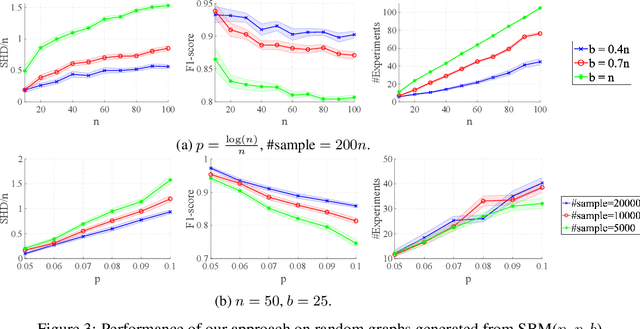
Abstract:We study experiment design for the unique identification of the causal graph of a system where the graph may contain cycles. The presence of cycles in the structure introduces major challenges for experiment design. Unlike the case of acyclic graphs, learning the skeleton of the causal graph from observational distribution may not be possible. Furthermore, intervening on a variable does not necessarily lead to orienting all the edges incident to it. In this paper, we propose an experiment design approach that can learn both cyclic and acyclic graphs and hence, unifies the task of experiment design for both types of graphs. We provide a lower bound on the number of experiments required to guarantee the unique identification of the causal graph in the worst case, showing that the proposed approach is order-optimal in terms of the number of experiments up to an additive logarithmic term. Moreover, we extend our result to the setting where the size of each experiment is bounded by a constant. For this case, we show that our approach is optimal in terms of the size of the largest experiment required for the unique identification of the causal graph in the worst case.
Combining Experimental and Observational Data for Identification of Long-Term Causal Effects
Jan 26, 2022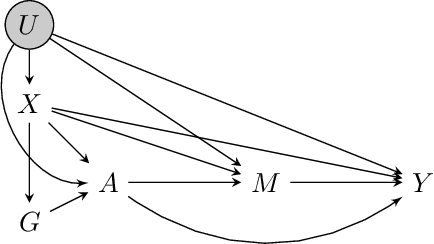
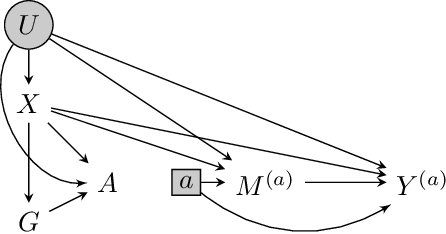
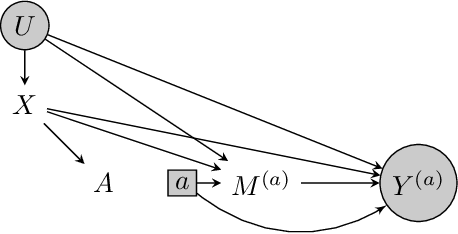
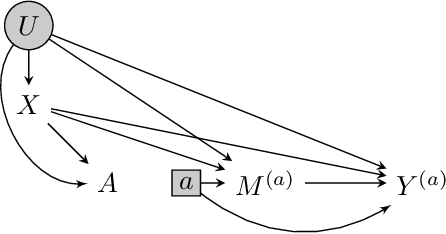
Abstract:We consider the task of estimating the causal effect of a treatment variable on a long-term outcome variable using data from an observational domain and an experimental domain. The observational data is assumed to be confounded and hence without further assumptions, this dataset alone cannot be used for causal inference. Also, only a short-term version of the primary outcome variable of interest is observed in the experimental data, and hence, this dataset alone cannot be used for causal inference either. In a recent work, Athey et al. (2020) proposed a method for systematically combining such data for identifying the downstream causal effect in view. Their approach is based on the assumptions of internal and external validity of the experimental data, and an extra novel assumption called latent unconfoundedness. In this paper, we first review their proposed approach and discuss the latent unconfoundedness assumption. Then we propose two alternative approaches for data fusion for the purpose of estimating average treatment effect as well as the effect of treatment on the treated. Our first proposed approach is based on assuming equi-confounding bias for the short-term and long-term outcomes. Our second proposed approach is based on the proximal causal inference framework, in which we assume the existence of an extra variable in the system which is a proxy of the latent confounder of the treatment-outcome relation.
Proximal Causal Inference with Hidden Mediators: Front-Door and Related Mediation Problems
Nov 04, 2021



Abstract:Proximal causal inference was recently proposed as a framework to identify causal effects from observational data in the presence of hidden confounders for which proxies are available. In this paper, we extend the proximal causal approach to settings where identification of causal effects hinges upon a set of mediators which unfortunately are not directly observed, however proxies of the hidden mediators are measured. Specifically, we establish (i) a new hidden front-door criterion which extends the classical front-door result to allow for hidden mediators for which proxies are available; (ii) We extend causal mediation analysis to identify direct and indirect causal effects under unconfoundedness conditions in a setting where the mediator in view is hidden, but error prone proxies of the latter are available. We view (i) and (ii) as important steps towards the practical application of front-door criteria and mediation analysis as mediators are almost always error prone and thus, the most one can hope for in practice is that our measurements are at best proxies of mediating mechanisms. Finally, we show that identification of certain causal effects remains possible even in settings where challenges in (i) and (ii) might co-exist.
Partially Intervenable Causal Models
Oct 31, 2021

Abstract:Graphical causal models led to the development of complete non-parametric identification theory in arbitrary structured systems, and general approaches to efficient inference. Nevertheless, graphical approaches to causal inference have not been embraced by the statistics and public health communities. In those communities causal assumptions are instead expressed in terms of potential outcomes, or responses to hypothetical interventions. Such interventions are generally conceptualized only on a limited set of variables, where the corresponding experiment could, in principle, be performed. By contrast, graphical approaches to causal inference generally assume interventions on all variables are well defined - an overly restrictive and unrealistic assumption that may have limited the adoption of these approaches in applied work in statistics and public health. In this paper, we build on a unification of graphical and potential outcomes approaches to causality exemplified by Single World Intervention Graphs (SWIGs) to define graphical models with a restricted set of allowed interventions. We give a complete identification theory for such models, and develop a complete calculus of interventions based on a generalization of the do-calculus, and axioms that govern probabilistic operations on Markov kernels. A corollary of our results is a complete identification theory for causal effects in another graphical framework with a restricted set of interventions, the decision theoretic graphical formulation of causality.
Causal Discovery in Linear Structural Causal Models with Deterministic Relations
Oct 30, 2021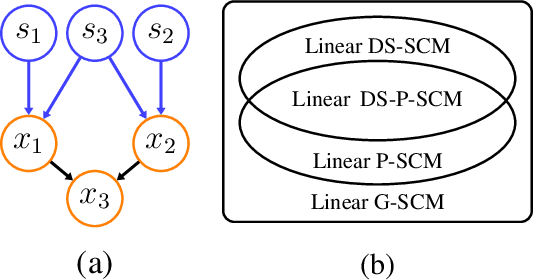
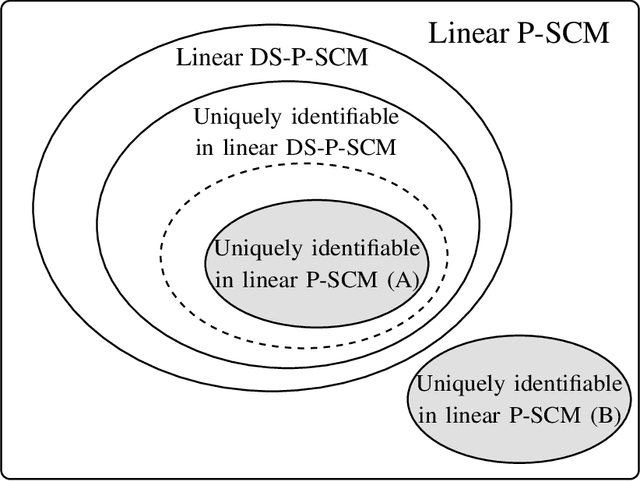


Abstract:Linear structural causal models (SCMs) -- in which each observed variable is generated by a subset of the other observed variables as well as a subset of the exogenous sources -- are pervasive in causal inference and casual discovery. However, for the task of causal discovery, existing work almost exclusively focus on the submodel where each observed variable is associated with a distinct source with non-zero variance. This results in the restriction that no observed variable can deterministically depend on other observed variables or latent confounders. In this paper, we extend the results on structure learning by focusing on a subclass of linear SCMs which do not have this property, i.e., models in which observed variables can be causally affected by any subset of the sources, and are allowed to be a deterministic function of other observed variables or latent confounders. This allows for a more realistic modeling of influence or information propagation in systems. We focus on the task of causal discovery form observational data generated from a member of this subclass. We derive a set of necessary and sufficient conditions for unique identifiability of the causal structure. To the best of our knowledge, this is the first work that gives identifiability results for causal discovery under both latent confounding and deterministic relationships. Further, we propose an algorithm for recovering the underlying causal structure when the aforementioned conditions are satisfied. We validate our theoretical results both on synthetic and real datasets.
 Add to Chrome
Add to Chrome Add to Firefox
Add to Firefox Add to Edge
Add to Edge